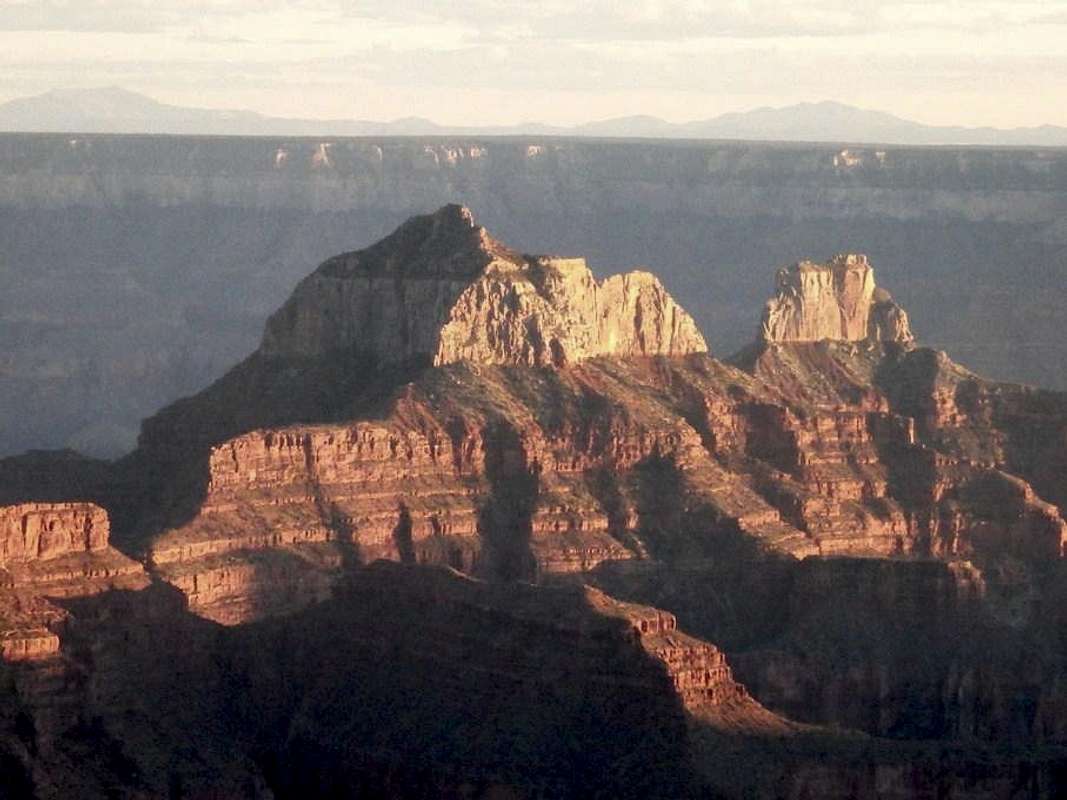|
|
Mountain/Rock |
|---|---|
|
|
36.13047°N / 112.03867°W |
|
|
Mountaineering, Scrambling |
|
|
Spring, Fall, Winter |
|
|
7551 ft / 2302 m |
|
|
Overview
Brahma Temple is one of the crown jewel summits of the Grand Canyon. One of the highest in the Bright Angel drainage and several miles off the North Rim, Brahma is one of the dominant features in Grand Canyon National Park and a coveted summit by GC climbers. First climbed in 1968, it sees only a handful ascents per year, many spending a night at Phantom Ranch or somewhere along the long and arduous approach. Even fewer make the push in a single day from the South Rim, being a roughly 30 mile roundtrip day with over 22,000′ of elevation change, which of course includes the painful 5,000′ ascent back to the South Rim to cap off the day. The approach consists of multiple pitches of class 4 climbing, many with fixed ropes shared for the approach of the more popular (and more difficult) Zoroaster Temple, holding some of the best backcountry rock climbing in the entire park. Regardless of the time spent climbing Brahma, it is far and away one of the most rewarding summits in the canyon. Take note, this summit has significant challenges in route finding with no water sources beyond Phantom Ranch, and is only recommended for experienced canyon adventurers.
Getting There
Most approaches from Brahma Temple start at Phantom Ranch at the bottom of the canyon. Any number of trails can get you there including the South Kaibab Trail, North Kaibab Trail and Bright Angel Trail. The South Kaibab Trail is the shortest for those attempting the summit in a single day. Please see the excellent Summitpost pages for the various trails for further details.
Route
Approach: From Phantom Ranch, continue north along the North Kaibab Trail about a quarter mile to the signed turn off for the Clear Creek Trail. Hike this up switchbacks to the Tonto layer for about a mile. Zoroaster Temple will stand tall above to the east, with Sumner Butte directly overhead. Leave the trail when you reach Sumner Wash, the first major drainage between Sumner Butte and Zoroaster Temple. Follow the wash up slope, ultimately aiming for the impossibly steep looking notch up to the saddle between the two summits. A use trail materializes to the climbers left side of the wash about half way up, bringing you the remaining distance to the base of the notch.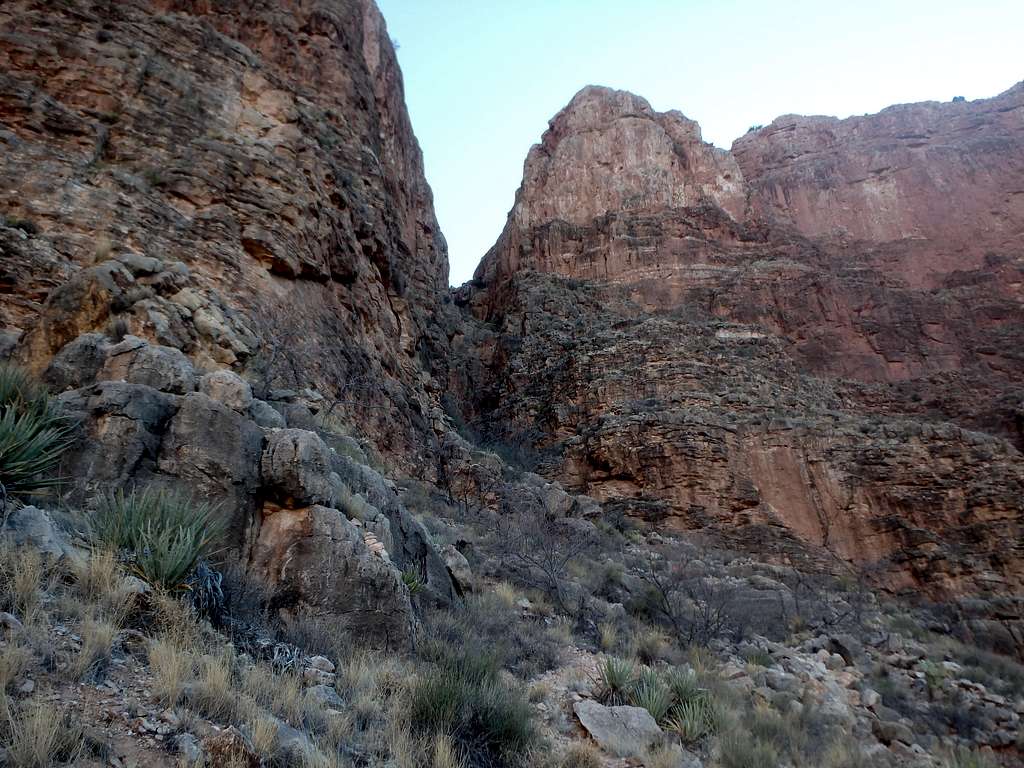
There is usually a fixed line at this point for rappelling. The route ascends a series of class 3 ledges to the right of the notch for about 100'. It is worthwhile to take note of the rope before starting up to get a feel of how high you need to climb. When the terrain gets a bit more difficult about 10' above the top of the first rope, down climb a steep groove back into the gully. There is sometimes a short rope to rappel this short downclimb, but it is straightforward class 3. From here scramble up the notch a short way until you reach the next fixed rope. This can be bypassed using cracks to the left, with a short exposed move back into the gully. Beyond this the gully switches to loose class 2 until you pop out onto the saddle between Sumner and Zoroaster, with Brahma Temple now in sight.
The next stage is a lot of scrambling through the Supai Redwall. Scattered cairns can be found along the way, but in general attack the cliff bands head on, traversing to the north whenever difficulties are encountered until a class 3 weakness can be found. In general, you shouldn't have to do anything harder than 15' of class 3 stemming.
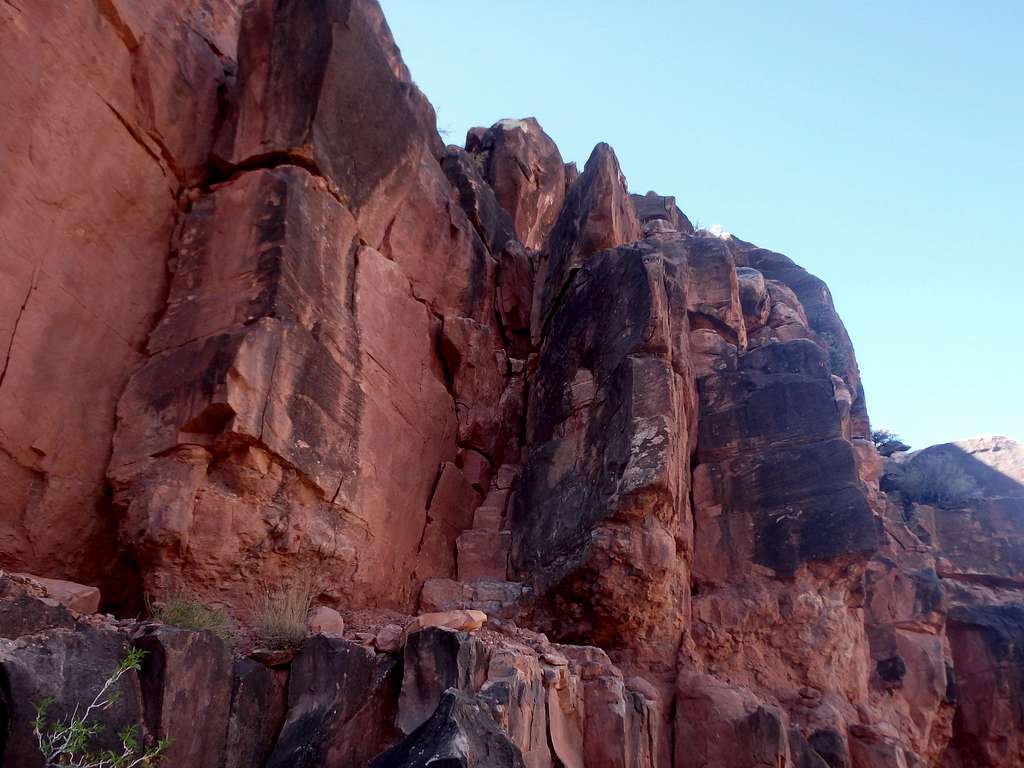
Eventually you'll breach the lower Supai bands and reach the broad lower western arm of Zoroaster Temple. The crux of the route is navigating through the final bands of Supai. Pick up a use trail that skirts the final Supai bands to the north. Follow this to one of the furthest rock bays in, almost directly beneath Zoroaster Temple. Here you should find the final series of fixed ropes. The first should be visible from the use trail, and a short 15' class 4 crack, with the rope fixed to a tree. Continue along a use trail up a class 3 slab (this may or may not have a fixed rope) to the crux- A short vertical 15' wall with a fixed rope. I feel confident saying this spot wouldn't be considered class 4 were it not for the rope, and more than a few have turned back at this point. Last I was there, there was a rope for rappelling as well as a second rope tied with knots for the ascent, which you could clip into as you went.
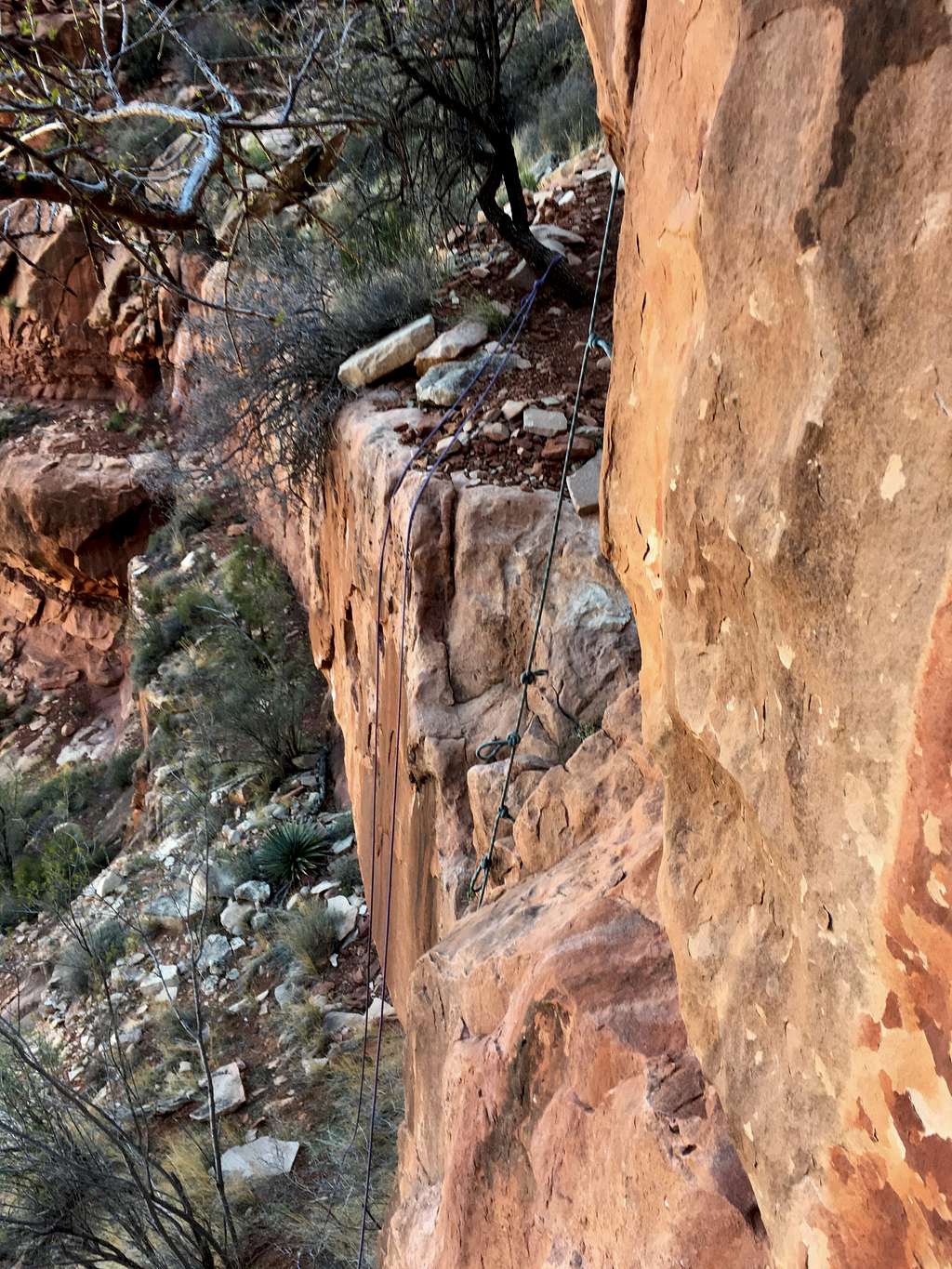
Once above the crux of the approach, you can either continue on the use trail up to the base of Zoroaster and drop down to the saddle with Brahma, or traverse above the upper Supai bands to the saddle directly. While this may be preferred, it does involve some loose side-hilling.
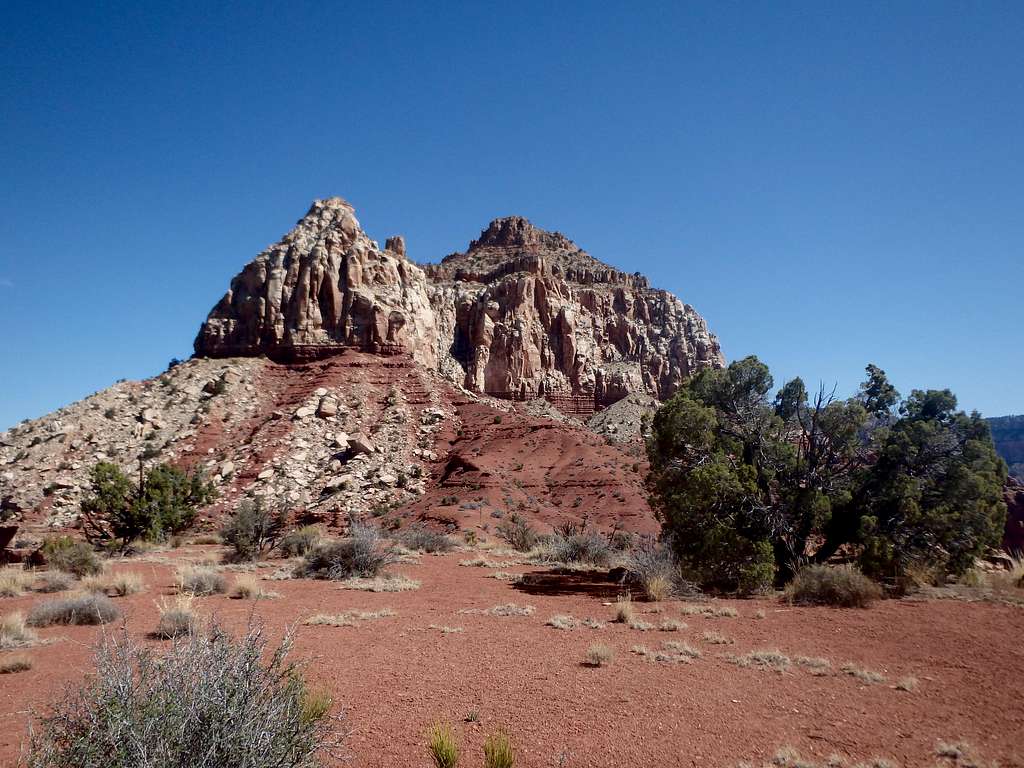
Route:
From the saddle, Brahma Temple is still over 1,000' above. The class 3-4 route ascends the northwest face, meaning a mile long traverse from the saddle to the base of the route. A use trail materializes as you round the corner along the rock face. Continue north until reaching one of the first spots that looks like it has an potential for non technical climbing, usually marked with a cairn. Some easy scrambling gets you to the only exposed move on this section of the route, a short slabby traverse about 20' up to bring you into a wide gully. From there, you have your work cut out for you with plenty of class 2 and 3 up a series of gullies and cracks to get you up the last 1000'.

There are many options here, so if something feels tough, move one or two gullies over and try again. Follow this all the way up the summit ridgeline before hooking back south towards the highpoint. There is just a little more scrambling left to get through one last rock layer, a little bit of Toroweap sitting on top of the Coconino Sandstone. Sign in the register and take in one of the most spectacular canyon views you've ever had. And try not to look at the south rim and think about how far you are from your car...
Red Tape
Admission to GCNP is $30 for 7 days. I highly recommend the "America the Beautiful" Pass for $80, which covers the entrance fees for all federally managed parks and land for one year. Permits are needed if planning on camping near Phantom Ranch. along the Clear Creek Trail or bivying near Brahma or Zoroaster. Reservations needed for Phantom Canyon.
When to Climb
As with most hiking in the Grand Canyon, Fall and Spring are the best. Summer will be brutally at that elevation in the canyon, and possibly deadly with those distances. Winter can bring ice on the northern faces of Brahma, and the upper route would probably hold some snow.
Camping
There are two developed campgrounds on the South Rim: Mather (which takes reservations) and Desert View. The closest backcountry campsite would be Phantom Canyon Ranch, and at permitted backcountry camping is available along the Clear Creek Trail approximately one mile from the turn off of North Kaibab. There is plenty of places for camping at large in the National Forest just outside the park.
External Links
Solo Trip Report: The Mountains Are Calling